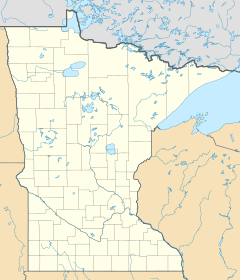Snake River (St. Croix River tributary) facts for kids
Quick facts for kids Snake River |
|
|---|---|
|
Mouth of the Snake River
|
|
| Physical characteristics | |
| River mouth | 45°49′31″N 92°45′58″W / 45.8254°N 92.7661°W |
The Snake River is a river in Minnesota, United States. It is about 104-mile-long (167 km). This river flows into the St. Croix River. It is one of three rivers in Minnesota that share this name.
The name "Snake River" comes from the Ojibwa name Ginebigo-ziibi. This name was given because the Dakota people lived along the river. The name of Kanabec County also comes from the Ojibwe word for this river.
Where the Snake River Flows
The Snake River and its smaller streams drain an area of about 1,009 square miles (2,610 km2). This area includes parts of Aitkin, Kanabec, Mille Lacs, and Pine counties.
The river starts in southern Aitkin County and first flows south. Then, it goes through Kanabec County. Near Mora, Minnesota, the river turns east. It follows a small crack in the Earth's surface. Finally, it flows into the St. Croix River. This meeting point is about 13 miles (21 km) east of Pine City, Minnesota. At Pine City, the river's water flow is about 650 cubic feet per second.
Lakes and Smaller Rivers Connected to the Snake River
Two important lakes are linked to the Snake River: Cross Lake and Pokegama Lake.
- Cross Lake is about 13 miles (21 km) from where the Snake River joins the St. Croix River. Its name comes from the Ojibwa word bimijigamaa. This means "a lake that crosses another body of water."
- Pokegama Lake is about 17.5 miles (28.2 km) from the river's mouth. Its name comes from the Ojibwa word bakegamaa. This means "a side-lake of another body of water."
Several smaller rivers flow into the Snake River. These are called tributaries. The main tributaries are:
- Knife River
- Ann River
- Groundhouse River
- Rice Creek
History and Culture Along the River
The Snake River and the Knife River were very important waterways. They connected the St. Croix River to Mille Lacs Lake.
A long time ago, Chief Kappamappa lived at Chengwatana. This place was at the mouth of the Snake River, as recorded by Henry Schoolcraft. Near Pokegama Lake, there is a stream called Mission Creek. This name comes from a Presbyterian mission that was there. This mission brought the first printing press to Minnesota. They used it to print books in the Ojibwe language.
During the time when treaties were being made, people called the Biitan-akiing-enabijig lived along this river. This name means "Border-sitters." These people were both Ojibwa and Dakota. They often had disagreements among themselves about whether they were Ojibwa or Dakota. This sometimes made it seem like the Mdewakanton Dakota Sioux and Ojibwa Nations were always fighting. Eventually, the Biitan-akiing-enabijig who saw themselves as Ojibwa joined the St. Croix Band of Lake Superior Chippewa. The Snake River sub-band then became part of the St. Croix Chippewa Indians of Minnesota. This group is one of the four tribes that make up the Mille Lacs Band of Ojibwe.
A fur trade post was built by the North West Company on the river in 1804. It was near where Pine City is today. This trading post was used for several years. Later, it was left empty and destroyed in a fire. The place where it stood was found again and dug up by archaeologists. A building and a fence were rebuilt. In 1970, it opened as a living history museum.
On a map from 1757, called the Mitchell Map, this river system was named "Portage River." This is because it was a key water route. It connected the St. Croix River to Mille Lacs Lake and the upper Mississippi River. People would carry their canoes and goods over a short land path, called a portage, to get from one river system to another.



